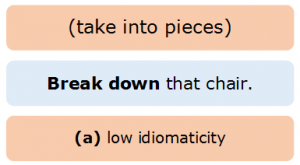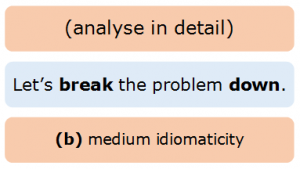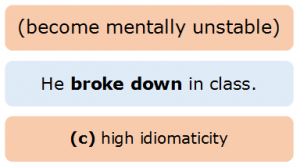What are the different types of phrasal verb?

This is the second of three chapters about Phrasal Verbs. To complete this reader, read each chapter carefully and then unlock and complete our materials to check your understanding.
– Attempt to categorise phrasal verbs into different types
– Discuss four ways that phrasal verbs can be categorised
– Provide examples of each phrasal-verb type
Before you begin reading...
-
video and audio texts
-
knowledge checks and quizzes
-
skills practices, tasks and assignments
Chapter 2
Having discussed what a phrasal verb is and why students so frequently make errors when attempting to use them, we should next understand how these constructions are categorised so that we can better recognise and utilise them. This chapter first explains three variables of phrasal verbs, which are idiomaticity, transitivity and separability, before discussing how a better understanding of the construction of a phrasal verb can assist you in determining these variables.
1. Idiomaticity
You may already be familiar with idioms in the English language, such as the saying ‘it’s raining cats and dogs’ which is used instead of ‘it’s raining heavily’, or ‘break a leg’ in place of ‘good luck’. What these idioms have in common is that their meaning cannot be known from the sum of their parts. As explained in Chapter 1, this is true of phrasal verbs, some of which have up to three levels of idiomaticity:



In (a), the spatial properties of the preposition ‘down’ are still present in that the chair can be broken apart and its pieces placed down onto the floor, meaning that the idiomaticity of this phrasal verb is quite low. While sentence (b) also maintains some of this spatial meaning in that the elements of the problem may be separated down into their smaller parts, clearly the meaning of this phrase is more idiomatic. Finally, the meaning of the phrasal verb in sentence (c) bears little resemblance to the original meaning of the individual words, although it does conjure some imagery of both the speaker breaking into pieces and perhaps collapsing down onto the floor.
2. Transitivity
While having a knowledge of idiomaticity may assist in understanding the meaning of a set of phrasal verbs, having confidence in a phrasal verb’s transitivity will help in writing that phrasal verb grammatically. But what is transitivity? Simply put, the transitivity of a verb measures whether or not that verb requires an object, such as ‘an assignment’. Phrasal verbs may therefore be intransitive (without an object) or transitive (with an object), such as in the following examples:


In example (d), the phrasal verb ‘give in’, meaning ‘to stop trying’, is intransitive and cannot take an object, while in (e), ‘give in’ is combined with the object ‘his assignment’ to demonstrate the meaning of ‘submission’. In (e), in fact, it would be ungrammatical to omit this object as the meaning of this phrasal verb would then be interpreted in the same way as (d). What is also clear from these examples is that two phrasal verbs which are identical in spelling may require different grammar. Transitivity is not the only way, however, in which a phrasal verb’s grammar may differ, as the separability of the elements is important too.
3. Separability
If we again take the phrasal verb ‘give in’ with the meaning of ‘submit’, then we can demonstrate something interesting with this construction:


Do you notice how in (g) the object ‘his assignment’ has been placed between the verb and the particle? This is because some phrasal verbs are separable (meaning that the elements can be separated in this way) and some are inseparable. There is one rule to remember here though: if the object is replaced with a pronoun such as ‘it’ or ‘they’, then the phrasal verb must be separated as is shown in (h). Looking at (i), it would in fact be ungrammatical not to separate constructions such as this:


4. Construction
But how can we know whether a phrasal verb is transitive or separable or not? The key here is to try to determine whether you’re dealing with a preposition or an adverbial particle. This can be difficult because both may often look and be spelled the same. However, the following rules may assist you here:

Even after understanding these four concepts about phrasal verb identification and use, it may still be difficult to apply this to your speech and writing. To assist you in this area, Chapter 3 provides charts for the most common phrasal verbs and informs you of their meanings and whether the constructions are transitive or separable.
Downloadbles
Once you’ve completed all three chapters about phrasal verbs, you might also wish to download our beginner, intermediate and advanced worksheets to test your progress or print for your students. These professional PDF worksheets can be easily accessed for only a few Academic Marks.
Collect Academic Marks
-
100 Marks for joining
-
25 Marks for daily e-learning
-
100-200 for feedback/testimonials
-
100-500 for referring your colleages/friends